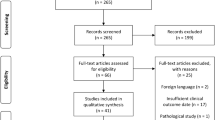Abstract
Background
Skull base osteoradionecrosis is a devastating post-irradiation complication in nasopharyngeal carcinoma patients. We conducted a retrospective analysis to assess the long-term survival and prognostic factors of patients with skull base osteoradionecrosis treated with endoscopic sequestrectomy.
Methods
We enrolled 59 nasopharyngeal carcinoma patients with skull base osteoradionecrosis who underwent endoscopic nasopharyngectomy. The clinical characteristics and outcome at the last follow-up visit were collected. The survival curve and univariate and multivariate survival analysis were analyzed by Kaplan–Meier and Cox proportional hazards model to analyze the potential prognostic factors of overall survival, including age, gender, number of radiation, number of operations, extension of disease (local or extensive), whether the ICA is exposed to the procedure (yes or no) and the hypha status (yes or no) at postoperative pathological examination.
Results
The predilection sites of skull base osteoradionecrosis in osteoradionecrosis patients are as follows: the base of the sphenoid bone and sphenoid sinus region, the clivus and petrous apex region including the internal carotid canal and the pterygoid process region (including its medial and lateral pterygoid plates). After surgery, clinical symptoms were alleviated in most patients to varying degrees. By the last follow-up visit, 26 patients had died. Most deaths (24) in the study occurred during the first 2 years. Most patients (24) died of sudden severe hemorrhage. The follow-up period ranged from 1 to 108 months, with a median of 27 months. The 2-year overall survival rate was 54.2%. Multivariate Cox regression analysis showed that the number of radiation (P = 0.026) and age (P = 0.002) were independent risk factors for the overall survival.
Conclusions
Endoscopic sequestrectomy with minimal complications and clear vision is a valuable option for the therapy of skull base osteoradionecrosis in nasopharyngeal carcinoma patients.





Similar content being viewed by others
References
Lin S, Lu JJ, Han L et al (2010) Sequential chemotherapy and intensity-modulated radiation therapy in the management of locoregionally advanced nasopharyngeal carcinoma: experience of 370 consecutive cases. BMC Cancer 10:39
Lee CC, Ho CY (2012) Post-treatment late complications of nasopharyngeal carcinoma. Eur Arch Otorhinolaryngol 269(11):2401–2409
Huang XM, Zheng YQ, Zhang XM et al (2006) Diagnosis and management of skull base osteoradionecrosis after radiotherapy for nasopharyngeal carcinoma. Laryngoscope 116(9):1626–1631
Chang KP, Tsang NM, Chen CY et al (2000) Endoscopic management of skull base osteoradionecrosis. Laryngoscope 110(7):1162–1165
Hua YJ, Chen MY, Qian CN et al (2009) Postradiation nasopharyngeal necrosis in the patients with nasopharyngeal carcinoma. Head Neck 31(6):807–812
Yang Q, Zou X, You R et al (2017) Proposal for a new risk classification system for nasopharyngeal carcinoma patients with post-radiation nasopharyngeal necrosis. Oral Oncol 67:83–88
Choi NY, Kim HJ, Baek CH (2017) Surgical management of extensive osteoradionecrosis in nasopharyngeal carcinoma patients with the maxillary swing approach and free muscular flaps. Clin Otolaryngol 42(5):1100–1104
Adel M, Chang KP (2016) Using a nasoseptal flap for the reconstruction of osteoradionecrosis in nasopharyngeal carcinoma: a case report. J Otolaryngol Head Neck Surg 45:27
Chen Z, Qiu QH, Zhan JB et al (2016) Endoscopic surgery and reconstruction for extensive osteoradionecrosis of skull base after radiotherapy for nasopharyngeal carcinoma. Zhonghua Er Bi Yan Hou Tou Jing Wai Ke Za Zhi 51(12):881–886
Xu YD, Ou YK, Zheng YQ et al (2008) Surgical treatment of osteoradionecrosis of the temporal bone in patients with nasopharyngeal carcinoma. J Laryngol Otol 122(11):1175–1179
Hao SP, Chen HC, Wei FC et al (1999) Systematic management of osteoradionecrosis in the head and neck. Laryngoscope 109(8):1324–1327 (discussion 1327–1328)
Rice N, Polyzois I, Ekanayake K et al (2015) The management of osteoradionecrosis of the jaws—a review. Surgeon 13(2):101–109
Marwan H, Green JM, Tursun R et al (2016) Recurrent malignancy in osteoradionecrosis specimen. J Oral Maxillofac Surg 74(11):2312–2316
Chen KC, Yen TT, Hsieh YL et al (2015) Postirradiated carotid blowout syndrome in patients with nasopharyngeal carcinoma: a case-control study. Head Neck 37(6):794–799
Swain RE, Biller HF, Ogura JH et al (1974) An experimental analysis of causative factors and protective methods in carotid artery rupture. Arch Otolaryngol 99(4):235–241
Soria JC, Deutsch E (2011) Hemorrhage caused by antiangiogenic therapy within previously irradiated areas: expected consequence of tumor shrinkage or a warning for antiangiogenic agents combined to radiotherapy. Ann Oncol 22(6):1247–1249
Shu CH, Cheng H, Lirng JF et al (2000) Salvage surgery for recurrent nasopharyngeal carcinoma. Laryngoscope 110(9):1483–1488
Low JS, Chua ET, Gao F et al (2006) Stereotactic radiosurgery plus intracavitary irradiation in the salvage of nasopharyngeal carcinoma. Head Neck 28(4):321–329
Acknowledgements
We thank all participating patients for their contributions to this study.
Author information
Authors and Affiliations
Corresponding author
Ethics declarations
Conflict of interest
No conflict.
About this article
Cite this article
Liu, J., Ning, X., Sun, X. et al. Endoscopic sequestrectomy for skull base osteoradionecrosis in nasopharyngeal carcinoma patients: a 10‑year experience. Int J Clin Oncol 24, 248–255 (2019). https://doi.org/10.1007/s10147-018-1354-8
Received:
Accepted:
Published:
Issue Date:
DOI: https://doi.org/10.1007/s10147-018-1354-8




